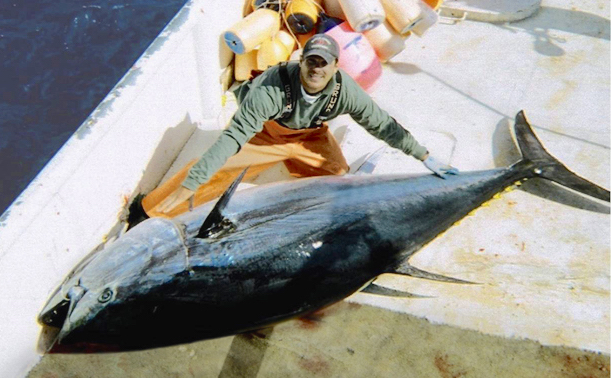
Tuna
Species Description
Atlantic bluefin tuna Thunnus thynnus
Bigeye tuna Thunnus obesus
Albacore tuna Thunnus alalunga
Skipjack tuna Katsuwonus pelamis
Little tunny Euthynnus alletteratus
Bonito Sarda sarda
Wild.
Tunas are saltwater predatory fish that make long migrations across the open ocean between spawning and feeding areas. For example, a good number of bluefin tuna found in the Gulf of Maine also spend time in the Gulf of Mexico, one of their primary spawning grounds. Tunas are built for speed and agility. They generally travel in schools, but the largest fish may hunt alone.
Season
June through September is considered the peak season for tuna fishing, as tunas are feeding heavily on baitfish in the Gulf of Maine during that time.
For the most recent updates on recreational fishing for tuna in Maine, visit the Maine Department of Marine Resources’ (DMR) website.
Status
The population level of Atlantic bluefin tuna in the Western Atlantic is unknown, but management measures are in place and the species is not subject to overfishing.
The bonito is heavily targeted for fishing, but is classified as a species of least concern for overfishing.
Atlantic skipjack populations are not overfished or subject to overfishing. Both bycatch and impact to habitat are minimal given that skipjack are harvested with rod-and-reel or handline systems.
Atlantic bigeye tuna are overfished, but the fishing rate under current management plans promotes population growth. Regulations are in place to minimize bycatch and gear used to target this species rarely contacts the ocean floor.
Little tunny is considered a species of least concern for overfishing.
Atlantic albacore tuna is not subject to overfishing nor is overfishing occurring. Fishing gear used to harvest this fish does not contact the ocean floor and regulations are in place to minimize bycatch.
Regulatory Authority
Atlantic bluefin, bigeye, skipjack, and albacore tuna are managed under the dual authority of the National Marine Fisheries Service Highly Migratory Species Division and the International Commission for the Conservation of Atlantic Tunas (ICCAT).
Commercial Harvest
Harpoon, purse seine, longline, rod-and-reel, and gillnetting are all used globally, but most tuna fished in the Gulf of Maine are caught using hook and line systems. See the vessel and gear guide for more information.
Recreational Harvest
For the latest information on current retention limits, visit NOAA Fisheries.
Recreational harvest for tunas is allowed only from a vessel with an Atlantic HMS angling permit.
Health Benefits & Risks
Bluefin tuna is a very good source of vitamin A, vitamin B12, and selenium. Bluefin tuna is also high in omega-3 fatty acids. Because bluefin tuna is a large, long-lived species that eats other fish, it may contain high levels of mercury.
Atlantic bigeye (“ahi”) tuna is a good source of selenium, vitamins B6 and B12, but is lower in omega-3 fatty acids than other types of tuna. Bigeye tuna can be high in mercury.
Skipjack (“light”) tuna is a good source of selenium and tends to be lower in mercury than other tunas. Skipjack tuna also tends to be slightly lower in omega-3 fatty acids than other types of tuna.
Albacore tuna is a very good source of vitamin B12, selenium, and omega-3 fatty acids. Canned albacore (“white”) tuna has more mercury than skipjack (“light” tuna).
There is a consumption advisory for tuna; Maine Center for Disease Control and Prevention advises that pregnant and nursing women, women who may get pregnant and children under eight years old eat no more than one meal of tuna steak or white canned tuna per week.
View the 2021 US Food and Drug Administration’s fish consumption guidelines.
Buying & Preparing
Tuna flesh ranges from very light pink (nearly white) to deep reddish brown, depending on the species. Avoid those with strong discoloration, or which have a dull, brownish cast or brown spots. The flesh should be firm and smell fresh, not “fishy.”
Some tuna (e.g., canned albacore tuna) is sold pre-cooked and can be added as a protein to many dishes including pastas, salads, and casseroles. Tuna can also be purchased in the form of steaks for searing or grilling.
Recipes
Certifications & Verifications
- Certified Sustainable by the Marine Stewardship Council
- Certified Dolphin-Safe by NOAA Fisheries
Links
- NOAA Fisheries Species Directory
- Tuna School: Crash Course on a Local Delicacy
